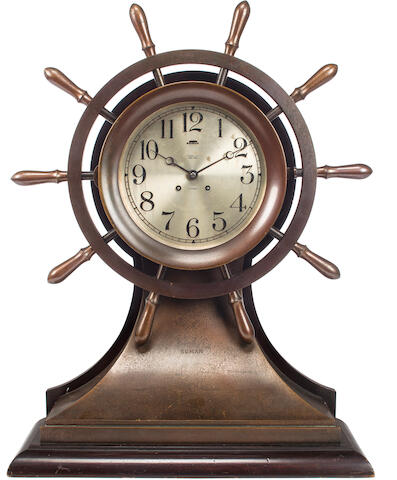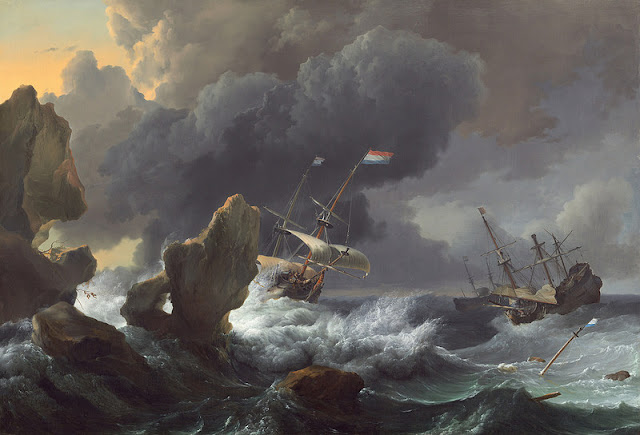A 8-1/2 inch "Mariner" clock for the yacht Sumar
Chelsea Clock Co., Boston, MA., for Tiffany and Co., circa 1926
25 x 20 x 8-1/2 in. (63.5 x 50.8 x 21.5 cm.), height x width x depth
Signed below the "12" on the dial "Tiffany & Co.", a Chelsea "Mariner" ship strike, with silvered face, Arabic numerals, slow/fast adjustment, double barrel key wind for the movement and strike, hinged face with a bronzed ten-spoke "ship's wheel" fiited to the casement, with supporting pedestal on a mahogany base.
Luca Papaluca (Italian, 1890-1934)
The American steam yacht Sumar of the New York Yacht Club
inscribed at the center "-Sumar.N.Y.Y.C.-"
signed lower right: "L. Papaluca"
watercolor, pastel, and gouache on paper
16 x 26 in. (40.6 x 66 cm.)
The yacht Sumar was commissioned by David C. Whitney (1865-1942) of Grosse Point, Detroit Michigan and named for his wife Susan Marshall. It was built of steel by the Todd Shipyards Corporation in Brooklyn NY.
The vessel was built in 1926 and was 160 feet long. Propulsion was by twin diesel engines which turned two propellers and produced 13 knots. The naval architect was Henry J. Gielow. Her beam was 26 feet and tonnage 319. The engines were built by Cooper-Bessemer and developed 420 horsepower. The vessel was manned by a crew of 21. In 1927 her captain was B. Madsen and in May she was in transit from Manila to Colombo Sri Lanka via Singapore.
By April 1931 the Sumar had logged 85,000 nautical miles of cruising, including a circumnavigation of the planet. She ranged from the east and west coasts of the Americas, the Mediterranean and Black Seas, the British Isles, Scandinavia, and the Caribbean. The first part of her route took her to Port of Spain, Rio, Montevideo, then to Hammerfest Norway. Her captain in 1930 was Barney, who had skippered the British war prize Germania and been responsible for 104 idle Hog Island-built ships for two years.
Sometime before June 1942 the Sumar was sold to the British and commissioned as HMS Sumar. In Bermuda she was listed as an anti-submarine vessel and was at one point under the command of Lieutenant Commander C. A. King, DSC, RNR. In July 1941 she was simply fitting out in Bermuda, but appears to have stayed there. The Sumar was based at Her Majesty’s Dockyard in Bermuda.
HMS Sumar’s commander was Lieutenant Gordon Emerson Kernohan of the Royal Canadian Naval Voluntary Reserve. A 1926 graduate of Upper Canada College. He was one of the survivors when the armed merchant cruiser (AMC) HMS Forfar (F 30) was sunk on the 2nd of December 1940 by Otto Kretschmer in U-99 west of Ireland. 172 of her complement of 193 perished.
Rear Admiral Jules James, officer in charge of the Naval Operating Base, Bermuda, ordered the USS Gannet and HMS Sumar to rescue the 65 survivors. Several aircraft were sent to the site of the sinking from Bermuda as well.
USS Gannet (AVP 8),
built in 1918 and sunk on 7 June 1942 by U-653 under Gerhard Feiler.
The USS Gannet was expecting a corvette to rendezvous with her five nautical miles east of what is now Gibbs Hill Light. Instead was unpleasantly surprised to find the converted yacht Sumar. It had no common communications signals, or working sonar, and both the radio and compass on the Sumar were defective. The resultant erratic changes in course made the Sumar yaw so much that Nuessle wryly observed she might has well have been zig zagging.
The converted yacht could only make 10 knots, and so the USS Gannet took up station, laboriously trying to stay within 500 yards of its companion during the voyage northwards. In order to stay in contact with each other, both ships rigged lights for the other to see, making them easier prey to lurking submarines. Since the airplanes found no survivors from the Westmoreland (they had already been rescued), at 1:00 pm on the 6th of June both navy ships were ordered back to Bermuda. By then they had sailed into the sites of a German U-boat, U-653 under Kapitänleutnant (later Korvettenkapitän) Gerhard Feiler.
Feiler was a determined adversary, however he underestimated the draft of the two ships he was aiming for. He lined up his torpedo shots at 4:20 am on the 7th of June. Remarkably, all four shots missed the mark. He fired another pair of torpedoes, set for just 2 meters depth. After 38 seconds he wrote that “Tender blows up immediately, presumably the magazine. Once the explosion cloud has cleared we can see only small pieces of sinking wreckage, debris from the blast is spread far and wide.” He noted that the HMS Sumar turned and headed towards the U-boat and observed seeing “emergency signals for about 10 min.”
Apparently HMS Sumar didn’t see the emergency signals, or mistook them for more mundane communications from her escort, as the ship motored on for Bermuda, arriving there without the USS Gannet the following day and causing a damaging rift between the American and British navies.
HMS Sumar was used as a training ship in 1944 and sold out of the service in 1946.
Luca Papaluca, The Elder (1890-1932). An Italian pier-head painter, working primarily in Port Naples, Italy. His works are primarily in gouache with the ship's name in print centered. Mt. Vesuvius is a common background element. Sometimes he painted a pair of paintings depicting the same vessel in fair and stormy weather.
“The David C. Whitney Yacht ‘Sumar’ named after his wife, Susan Marshall Whitney."
Grosse Pointe (Michigan)
Historical Society
Acknowledgment: Uboats Bermuda,
Images are copyright of their respective owners, assignees or others. Some Images may be subject to copyright
I do not sell art, art prints, framed posters or reproductions. Ads are shown only to compensate the hosting expenses.
If you enjoyed this post, please share with friends and family.








![Luca Papaluca (Italian, 1890-1934) The American steam yacht Sumar of the New York Yacht Club 16 x 26 in. (40.6 x 66 cm.) [not examined out of the frame]](https://images2.bonhams.com/image?src=Images/live/2014-11/25/9091901-1-1.jpg&width=640&height=480&autosizefit=1)












